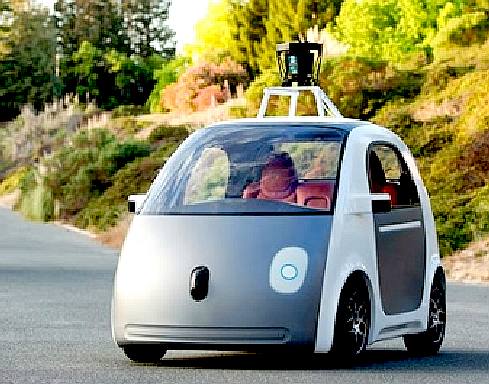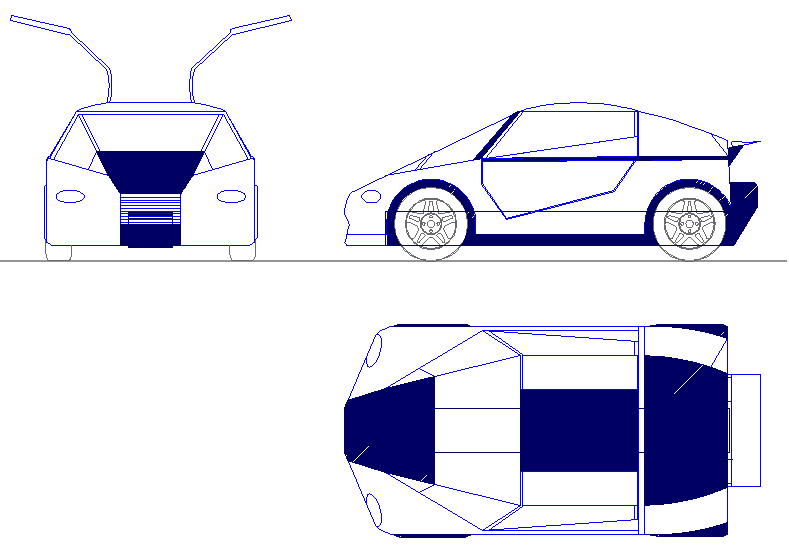|

It
may not win any prizes for design appeal, but for this little bubble-car beauty
is under the skin - it has a brain, and a whole load of sensors with which to
play I Spy. Well, actually, it's not that far advanced - it cannot think to be
creative. One day maybe.
THE
GUARDIAN - 22 AUGUST 2014
Google’s prototype self-driving car was unveiled to much fanfare with just two buttons – stop and go – for its test-track existence. But the introduction of new rules from the
California department of motor vehicles (DMV) means the company will have reintroduce that near-obsolete technology known as a “steering wheel” and a “brake pedal”.
The regulations, which come into effect in mid-September, set out the safety procedures companies must adopt before they can test autonomous vehicles in the state. The new rules include procedures for reporting accidents, licensing requirements for the cars themselves, a $5m insurance bond against accidents, and a number of limitations on who is allowed to test the cars.
Crucially, they require that the human drivers of the cars sit in a driver’s seat and be able to take “immediate manual control” of the vehicle if the autonomous driving system disengages or misbehaves.
The California DMV confirmed that in order to comply with the requirement, the prototype self-driving cars – whose physical controls currently consist just of two buttons and a touch screen – will have to be retrofitted with a steering wheel and pedals.
“With these additions, our safety drivers can test the self-driving features, while having the ability to take control of the vehicle if necessary,” a Google spokeswoman told the Wall Street Journal.
Alongside the requirement for manual controls, California’s regulations also require companies testing manual cars to submit an annual report to the DMV, and pay a
$150 fee for a permit allowing them to test up to 10 vehicles with 20 licensed drivers. And bikers will have to wait a bit longer: the rules ban autonomous motorbikes.
What’s more, the prospect of driving an autonomous vehicle without a license remains distant.
The new rules actually require test drivers to be more qualified than they would be to drive a normal car: they must have “been licensed to drive a motor vehicle for the three years immediately preceding application to the department”, have no more than one point on their license, never have been behind the wheel when injuring someone, and not have been convicted for drunk driving in the last decade.
Google has posted a number of videos showing people in its self-driving cars - including a man with limited vision, sitting in the driving seat of an adapted car
traveling over a “carefully planned route”. As on-the-road testing of Google’s cars comes nearer, more and more specifics are being made public as to how the cars will operate.
Although the prototype cars will have a top speed of 25mph, the lead software engineer of the project told Reuters that the another version of the car, built around a Lexus SUV, can be programmed to exceed the speed limit by up to 10mph if doing so leads to a safer drive.
Since sticking to the speed limit can be dangerous if surrounding traffic is exceeding it, Dmitri Dolgov says that the cars are programmed to go up to
10mph above the limit if traffic conditions warrant.
While that might be safer, it remains to be seen if Google could persist with that attitude legally. In Britain, a department for transport spokesman told the BBC that “There are no plans to change speed limits, which will still apply to driverless cars”.
THE
GOOD, THE BAD and the UGLY -
THE
GOOD
Unveiling a car with a top speed of 25mph, two seats and no pedals or steering wheel might not make much of an impression at a motor show. But Google, late on
Tuesday (MAy 2014), in the US, sent a minor earthquake through the car and taxi industry as it unveiled the latest version of its driverless car.
Driverless
is one step closer to autonomy, but the car is not autonomous, for that would
require a renewable energy source - or the ability to pull up to a petrol pump
and serve itself (and pay). Red Bull successfully won a competition laid down by
DARPA
for just about the same technology - so it's nothing new, save for the testing
program and possibly the long term agenda for the project, which, hats off to
Google for that.
The electrically-powered vehicle, which Google has begun testing around its headquarters in Mountain View, California, dispenses with all the normal controls, including foot pedals. Instead it has a
smartphone app that summons it and tells it the destination, and a single STOP button mounted between the two front-facing seats in case the occupants need to override the computer.
The car, in fact, takes over all the tasks of navigation, steering, acceleration and braking.
The company is building about 100 prototypes for a two-year test. The company's co-founder, Sergey Brin, told a conference in California that the vehicle was "still in the prototype stage" but that the project was "about changing the world for people who are not well-served by transportation today".
He said of the car: "You're just sitting there, no steering wheel, no pedals. For me it was very relaxing. In about 10 seconds after getting in, I forgot I was there. It reminded me of catching a chairlift by yourself, a bit of solitude I found really enjoyable."
Google says that the principal aim of the project is to improve safety, and that because the car is constructed with impact-absorbing foam at the front and a plastic windscreen, "it should be far safer than any other car for pedestrians".
The cars, which have been built specially by a company (as yet unnamed) in Detroit, will be used to investigate further how best to make driverless vehicles work. Google will run a pilot programme using the cars, which are not yet for sale.
One challenge is creating high-definition scans of the roads and surroundings before the cars can drive along them, because they cannot gather and process enough information in real time.
So far there are high-detail maps of about 2,000 miles of California's roads, but the state has more than 170,000 miles of public roads.
Google says it is interested in licensing the technology to traditional vehicle manufacturers once it has refined it sufficiently. Members of the team had been working on the project even before joining Google, for more than a decade.
But the prospect of driverless cars replacing human-driven taxis has been the cause of some alarm.
Dennis Conyon is quoated as saying: "If you get rid of the driver, then they're
unemployed." Dennis is the south-east director for the UK National
Taxi Associations. "It would have a major impact on the labour force."
London has about 22,000 licensed black cabs, and Conyon estimates that the total number of people who drive taxis for hire in the UK is about 100,000.
However, Steve McNamara, general secretary of the 10,500-strong London Taxi Drivers' Association, said: "You won't get these [driverless cars] in London for 20 or 25 years. Maybe by then they'll have a charge point – because there isn't a single one in London now."
Other car makers including Volvo, Ford and Mercedes, are working on driver-assisted vehicles, which, unlike Google's version, do not dispense with the driver controls.
But Chris Urmson, director of the self-driving car project at Google, said that the new prototypes dispensed with the steering wheel and brakes because there was no guarantee that a human occupant would be able to take over in an emergency, and that it was simpler just to have an emergency stop button.
Urmson said: "The vehicles will be very basic. We want to learn from them and adapt them as quickly as possible. But they will take you where you want to go at the push of a button. And that's an important step towards improving road safety and transforming mobility for millions of people."
So far the Google versions of the self-driving cars have covered 700,000 miles without an accident caused by the computer. The company points out that thousands of people die each year on the roads, and that about 80% of crashes can be ascribed to human error.
But they could have some way to go to match Conyon at the National Taxi Association. Aged 79, he has been driving a taxi for 50 years, and claims never to have had an accident.
We say well done on that to Dennis. But, we think that even the Google car is
bound to be involved in accidents that it cannot foresee, let alone avoid. It is
inevitable. That is unless all of the cars on the road have the same system and
there is some eye in the sky to direct the traffic. Hey, wait a minute, don't
they have such a system for ships: AIS
28 MAY 2014 - GOOGLE'S DRIVERLESS CAR - MORE GOOD
Google unveils the first of 100 test vehicles is with no steering wheel or pedals, two seats and a top speed of 25mph.
Google has demonstrated its own driverless car, a design that does away with all conventional controls including the steering wheel, and says it will build 100 of the vehicles for testing with the eventual aim of "bringing this technology to the world safely".
The company had for several years been testing everyday cars equipped with sensors, navigation equipment and computers to drive themselves but in the meantime it has secretly developed a prototype from scratch that will have no facility for a human to take control, other than an emergency stop button.
An initial 100 testbed versions would retain manual controls, Google said as it unveiled the car on Tuesday. The controls are needed to comply with the law in California which along with Nevada and Florida allows autonomous vehicles but only if a driver can take charge.
Chris Urmson, director of Google's self-driving car project, said the aim was to run extended tests in California where Google is based. Urmson argued driverless cars would improve road safety, calling the development "an important step toward improving road safety and transforming mobility for millions of people".
Google said its testing had suggested it was safer to remove conventional controls altogether because the results of a human having to take over suddenly and unexpectedly were unpredictable and potentially dangerous. “We saw stuff that made us a little nervous,” Urmson told the New York Times.
The toy-like concept vehicle has two seats, a screen displaying the route and a top speed of 25mph (40km/h). An array of sensors allows the vehicle's computer to determine its location and surroundings and it can "see" several hundred metres, according to Google.

THE
BAD - MAY 2014 SEARCH
ENGINE CIRCUS - ARGENTINEAN MODEL: MARIA BELEN RODRIGUEZ BATTLES SEARCH ENGINES
Rodriguez filed a lawsuit against Google and Yahoo in 2006 for search results that link her to pornographic sites. As part of that suit, Rodriguez won the equivalent of $15,000 U.S. (which was later lowered to $6,200).
According to Rodriguez, these results have "ruined" her life and done damage to her reputation. As a wife and mother, she is embarrassed and would like the links to the pornographic sites removed immediately. While she believes in freedom of speech her goal is to set a precedent so that this same situation doesn't happen to someone else.


No
disrespect to Maria, she is a good looking lass, but when we did a search we
were not confused with the other Argentinean with a similar name. Admittedly, we
already had the benefit of reading her story, so perhaps not armed with that
knowledge it might be different - but for how long? Not very long we suspect,
not with all the coverage she has generated. It may have been a different story
earlier.
GOOGLE SAYS:
"Search engines are neutral platforms that do not create nor control content on the web,” Google said in a statement to CNN. One of the interviewees in the CNN video argued that the creators of content should be held responsible, not the search engines.
As we await the verdict from the Argentinian high court we wonder who should be responsible for removing defaming content from the Internet? Is it the person who created the content? Is it the search engine providing links to the content?
What's your
take?
Remember
though that with genuine defamation (something that is not true) there is always
recourse to the civil courts. Publish only what you know to be accurate. Where
would we be without search engines. Back in the digital stone age.
THE
UGLY - IS YET TO COME WE SUSPECT
LINKS
& REFERENCE
The
Guardian 2014 August google-self-driving-car-steering-wheel
New
York Daily News model-google-yahoo-linking-pics-porn-article
The
Guardian 2014 May self-driving-cars-google-success
The
Guardian 2014 May google-driverless-car-mobility-safety-taxi-drivers
Google-reveals-driverless-car-prototype
http://www.theguardian.com/technology/2014/aug/22/google-self-driving-car-steering-wheel?CMP=EMCNEWEML6619I2
http://www.nydailynews.com/news/world/model-google-yahoo-linking-pics-porn-article-1.1806826
http://www.theguardian.com/technology/2014/may/28/self-driving-cars-google-success
http://www.theguardian.com/technology/2014/may/28/google-driverless-car-mobility-safety-taxi-drivers
ACRONYMS
& ABBREVIATIONS A-Z
ACOMMS acoustic communications systems
ACTD Advanced Concept Technology Demonstration
AEHF advanced extremely high frequency
AGV automated guided vehicle
AINS Autonomous Intelligent Network and Systems (initiative)
ANS Autonomous Navigation System
ARPA Advanced Research Projects Agency
ARTS All Purpose Remote Transport System
ATD Advanced Technology Demonstration
AV autonomous vehicl
C2 command and control
C2S Command and Control System
C2V command and control vehicle
C3 command, control, and communications
C3I command, control, communications, and intelligence
C4 command, control, communications, and computers
C4I command, control, communications, computers, and intelligence
CDL common data link
CECOM Communications Electronics Command
CHBDL common high-bandwidth data link
COMINT communications intelligence
CONOPS concept(s) of operations
COTS commercial off-the-shelf
CSP constraint satisfaction problem
CTFF Cell Transfer Frame Format
CWSP Commercial Wideband Satellite Program
DARPA Defense Advanced Research Projects Agency
DOT Department of Transport
EHF extremely high frequency
ELINT electronic intelligence
EM/EO electromagnetic/electro-optical
EMS electromagnetic sensing
EO/IR electro-optical/infrared
FDI fault detection and isolation
FDOA frequency difference of arrival
FMEA failure modes and effects analysis
FOC final operational capability
Gbps gigabits per second
GBS Global Broadcast System
GEOS Geosynchronous Earth Orbit Satellite
GHz gigahertz
GIG Global Information Grid
GIG-BE Global Information Grid-Bandwidth Expansion
GIG-E Globat Information Grid-Expansion
GPS Global Positioning System
HAE high-altitude and -endurance
HALE high-altitude, long-endurance
HDTV high-definition television
HMMWV high mobility multipurpose wheeled vehicle
IMINT imagery intelligence
IMU inertial measurement unit
IOC initial operating capability
IP Internet Protocol
IR infrared
JPO Joint Program Office
JSTARS Joint Surveillance Target Attack Radar System
kbps kilobits per second
LADAR laser detection and ranging
L/D lift to drag (ratio)
LD MRUUV large-diameter multi-reconfigurable UUV
LDR low data rate
LEOS Low Earth Orbiting Satellite
LIDAR light detection and ranging
LOA level of autonomy
LOS line of sight
LRIP low-rate initial production
MAE medium-altitude and -endurance
MARS Mobile Autonomous Robot Software
MCG&I mapping, charting, geodesy,and imagery
MDARS-E/I Mobile Detection Assessment Response System-Exterior/Interior
MDR medium data rate
MICA Mixed Initiative Control of Automa-teams (program)
MMS Mission Management System
MPM mission payload module
MP-RTIP Multi-Platform Radar Technology Insertion Program
MRD Maritime Reconnaissance Demonstration (program)
MRUUV multi-reconfigurable UUV
MTI moving target indicator
MULE multifunction utility logistics equipment (vehicle)
NBC nuclear, biological, and chemical
NII Networks and Information Integration
NMRS Near-term Mine Reconnaissance System
NRC National Research Council
NRO National Reconnaissance Office
O&S operations and support
OCU operator control unit
ODIS Omni-Directional Inspection System
OODA observe-orient-decide-act
OTH over-the-horizon
PEO Program Executive Office
Perceptor Perception for Offroad Robotics
PMS Program Management Office
QDR Quadrennial Defense Review
R&D research and development
REMUS Remote Environmental Monitoring Unit System
RF radio frequency
RHIB rigid hull inflatable boat
RMP Radar Modernization Program
RONS Remote Ordnance Neutralization System
ROV remotely operated vehicle
RTIP Radar Technology Improvement Program
S&T science and technology
SA situation awareness
SAR synthetic aperture radar
SAS synthetic aperture sonar
SATCOM satellite communications
SDD System Development and Demonstration
SDR Software for Distributed Robotics
SFC specific fuel consumption
SHF superhigh frequency
SIGINT signal intelligence
SIPRNET Secret Internet Protocol Router Network
SLAM simultaneous localization and mapping
SOC Special Operations-Capable
SRS Standardized Robotics System
TALON one robot solution to a variety of mission requirements
TAR tactical autonomous robot
TCA Transformational Communications Architecture
TCDL tactical common data link
TCO Transformational Communications Office
TCP Transmission Control Protocol
TCS Tactical Control System
TDOA time difference of arrival
TPED task, process, exploit, disseminate
TPPU task, post, process, use
TRL Technology Readiness Level
TUAV tactical unmanned aerial vehicle
UCS Unmanned Control System
UGCV Unmanned Ground Combat Vehicle (program)
UGS unattended ground sensor
UGV unmanned ground vehicle
UHF ultrahigh frequency
VHF very high frequency
VMS Vehicle Management System
WNW wideband network wave form
XUV experimental unmanned vehicle

The
Ecostar carries solar panels to provide some level of autonomy.
She may also be ordered with a joystick, doing away with the usual floor
pedals and steering controls and placing them on one column. This car also
has built in energy cartridge loaders, once again providing another level
of autonomy when compared to other electric cars that can only plug into
an electricity outlet and fast charge.
|




